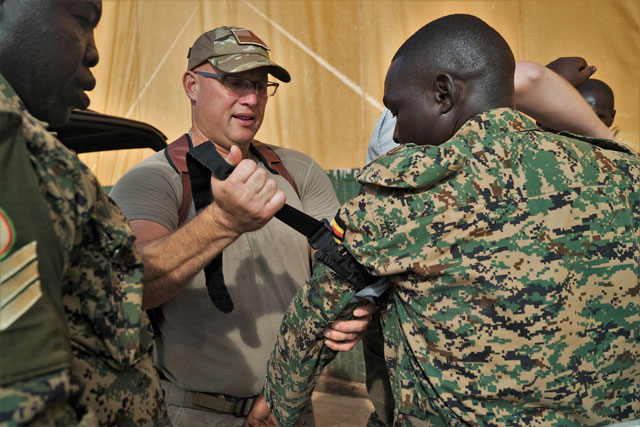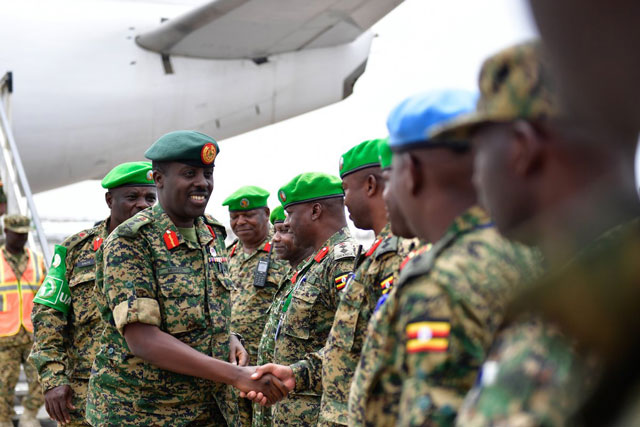
Kampala, Uganda | THE INDEPENDENT & XINHUA | Commanders of The African Union Mission in Somalia (AMISOM) face an anxious next 30 days with Ugandan President Yoweri Museveni’s eyes on an election at home while US President Donald Trump is ordering a reduction of troops from the region.
The US has up to 700 elite troops involved mainly in training Somalia and AMISOM units, while Uganda, with over 6,000, is a top African contributor to the ongoing peacekeeping efforts. They are in Somalia to assist local forces against al-Shabaab terrorists who an affiliate of al Qaeda.
Uganda has previously outlined long term plans to reduce its troop levels, but an election in January is likely to be followed by a firm decision on the way forward. Currently the military component of AMISOM is comprised of troops drawn from Uganda, Burundi, Djibouti, Kenya and Ethiopia who are deployed in six sectors covering south and central Somalia.
Trump lost the US election, and the Pentagon confirmed he had decided to change troop levels in Somalia, Syria and Afghanistan before he leaves office – by January 15, 2021.
“The President of the United States has ordered the Department of Defense and the United States Africa Command to reposition the majority of personnel and assets out of Somalia by early 2021,” the Pentagon said in a statement Friday.

The Pentagon was however quick to reassure it is not a change of policy. “While a change in force posture, this action is not a change in U.S. policy,” the Pentagon said.
“As a result of this decision, some forces may be reassigned outside of East Africa. However, the remaining forces will be repositioned from Somalia into neighboring countries in order to allow cross-border operations by both U.S. and partner forces to maintain pressure against violent extremist organizations operating in Somalia,” the Pentagon said in their statement.
US operations in the region are coordinated by Stuttgart-based AFRICOM, who in conjunction with Somali National Security Forces, are providing direct support to the five primary troop contributing countries in the African Union Mission in Somalia – Uganda, Kenya, Burundi, Djibouti and Ethiopia.
Ugandan troops are deployed in Sector 1, which comprises the regions of Banadir, and Lower Shabelle.
Kenyan forces are responsible for Sector 2 comprising Lower and Middle Jubba. Sector 3 comprising Bay and Bakool as well as Gedo (Sub Sector 3) comes under Ethiopian command.
Djiboutian forces are in charge of Sector 4 which covers Hiiraan and Galgaduud while Burundian forces are in charge of Sector 5 which covers the Middle Shabelle region.
NEWS: AFRICOM commander travels to #EastAfrica
—
“We must continue to work together & deliver whole-of-government, international, & #African solutions to address regional issues.”–@USArmy Gen. Stephen Townsend
Read more: https://t.co/KeDFlRASin pic.twitter.com/1qycQ98tmw
— US AFRICOM (@USAfricaCommand) November 27, 2020
Since firing Defense Secretary Mark Esper by tweet November 9, Trump has made several changes in troop positions in Somalia, Afghanistan and Iraq.
The plan is that of ‘repositioning’ troops from Somalia into neighboring countries in order to allow cross-border operations by both US and partner forces to maintain pressure against violent extremist organizations operating in Somalia
Al-Shabaab has been driven from Somalia’s major cities and towns but still has much influence in southern Somalia, carries out terrorist attacks in Mogadishu and commands some 5,000-10,000 fighters.
Last week acting Secretary of Defense Christopher Miller and U.S. Army Gen. Stephen Townsend, commander of U.S. Africa Command, made an unannounced visit to Somalia on November 27, the first by an American defense secretary.
“We enjoy close cooperation with our East African partners. Partnership and a range of U.S. assistance remains critically important to the stability, security, and prosperity of this region,” said Townsend. “We must continue to work together and deliver whole-of-government, international, and African solutions to address regional issues.”
Force Commanders
| No. | Name | Nationality | From | To | Note |
|---|---|---|---|---|---|
| 1 | Maj. Gen. Levi Karuhanga | 14 February 2007 | 3 March 2008 | ||
| 2 | Maj. Gen. Francis Okello | 3 March 2008 | 7 July 2009 | ||
| 3 | Maj. Gen. Nathan Mugisha | 7 July 2009 | 15 June 2011 | ||
| 4 | Maj. Gen. Fredrick Mugisha | 15 June 2011[63][64] | 2 May 2012 | ||
| 5 | Lt. Gen. Andrew Gutti | 3 May 2012 | 16 December 2013 | ||
| 6 | Lt. Gen. Silas Ntigurirwa | 16 December 2013 | 15 December 2014 | ||
| 7 | Lt. Gen. Jonathon Kipkemoi Rono | December 2014 | 23 December 2015 | ||
| Maj. Gen. Nakibus Lakara | December 2015 | Temporarily acting in role | |||
| Maj. Gen. Mohamedesha Zeyinu | March 2016 | Temporarily acting in role | |||
| 8 | Lt. Gen. Osman Noor Soubagleh [ | 18 July 2016 | 31 January 2018 | ||
| 9 | Lt. Gen. Jim Beesigye Owoyesigire | 31 January 2018 | 31 January 2019 | ||
| 10 | Lt. Gen. Tigabu Yilma Wondimhunegn | 31 January 2019 | August 2020 | ||
| 11 | Lt. Gen. Diomede Ndegeya | August 2020 | incumbent |
Somalia collapsed as a state, beginning in the late 1980s, and the Somali people have suffered some 30 years of war, displacement, and famine ever since.
The Somali conflict has crossed borders, primarily into Kenya, where large-scale and high profile terrorist attacks have killed hundreds of innocent civilians, including college students in their dormitories and shoppers in a Nairobi mall. There were also attacks against civilians in Kampala, Uganda.
ESTIMATED Troop numbers
| Country | Armed personnel (current) | Casualties | ||
|---|---|---|---|---|
| Troops | Police | Killed | Missing or captured | |
| 6,223 | 201 | 110 -2,700+ | ||
| 5,432 | 95+ | 4 missing, 1 captured | ||
| 4,395 | 2+ (supposedly) | |||
| 3,664 | 48 | 36–11 | ||
| 960 | 8+ | |||
| 0 (formerly 850)* | 47 | 1 | ||
| 200 | ||||
| 56[228] | ||||
| Total | 20,674 | 550+ | 1,108-3,000+ | 5 |
- * The reason why troops from Sierra Leone were withdrawn was the inability to rotate in fresh soldiers, due to the Ebola outbreak
 The Independent Uganda: You get the Truth we Pay the Price
The Independent Uganda: You get the Truth we Pay the Price



